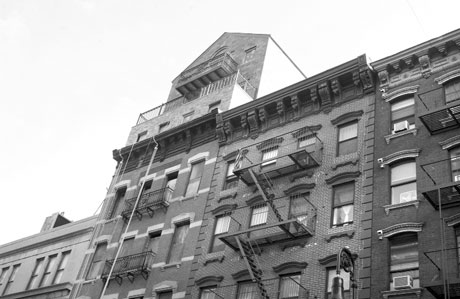By Jessica Mintz
Volume 16 • Issue 24 |November 11 – 17, 2003
New hotel looks to connect with the old neighborhood
On Orchard St. between Delancey and Broome, the road is paved with cobblestones — or at least looks like it. The block is a mix of the truly old and the newly old. Longtime sellers of furniture and alligator skin shoes face off with the Tenement Museum and the Laboratorio Del Gelato, but all share the nightly glow of recently installed bishop’s crook-style street lamps.
Looking south, the tenement facades line up neatly, a trademark view that Jewish immigrants knew and their children and their grandchildren still travel to the Lower East Side to see. It is only when the eye wanders to the rooftops that a clue to the block’s latest addition pops out: 100 Orchard St. seems to have sprouted a whole new building.
Randy Settenbrino stands across the street and looks over at this building — his building — from a high stoop. One hundred Orchard is full of construction workers, exposed wires and pipes and metal and dust, but the three new-looking floors that have grown out of the top of this five-story tenement are proof that Settenbrino’s vision is well on its way.
Developers today “are building cheap vanilla white boxes, killing the facades,” says Settenbrino, 42. “There is not much respect for the architecture. They’re imposing their will on the structures. I decided I wanted to do something special.”
That special something is the Blue Moon, an eight-story, 22-suite hotel that Settenbrino hopes will honor the “soul” of the building and the neighborhood’s immigrant past by retaining the original tenement’s facade and fire escape design, and mixing elements of the old interior with simple, luxurious rooms that have a period feel. On the ground floor, Settenbrino is even planning a kosher restaurant specializing in immigrant fare (complete with a takeout window to lure the neighborhood’s younger, cooking-impaired residents).
Settenbrino’s been on the block for years as a merchant, selling high-end Italian menswear at a store called Moda Moda. The opportunity arose to buy half of 100 Orchard in 1996; after several years of wrangling with the owner of the other half, he completed the purchase in 2000.
Years ago, says Settenbrino, buildings like his would have two stores on the ground floor. While they were designed for apartments upstairs, the costs and bureaucracy involved with being a New York City landlord became increasingly prohibitive, and much of the time, the upper floors would sit empty.
When 100 Orchard was gutted, Settenbrino was on site, the guardian angel of every artifact that might be salvaged, refinished by hand and reinstalled in the building: walnut shingles, old armoires, banister posts, period illustrations and old locks, horseshoes and bottles.
“We even found poker chips and bullets,” says Settenbrino, “in the same room!”
Settenbrino, with a newsboy cap perched jauntily on his head and a smart vest hiding much of his gray striped shirt, doesn’t fit exactly into the modern era. He chats in Yiddish with local business owners, and his office on Essex St. is like a community center, he says, with everyone stopping by to use the fax. Although his family has been in America for a few generations, he channels his Jewish/Italian immigrant past into an enthusiasm for the trappings of the old days. When the hotel opens in spring of 2004, Settenbrino hopes the staff will share his appreciation for the 1920s and ’30s, down to his love for what he calls the fun music of the time — Jimmy Durante, Eddie Cantor, Benny Goodman.
Settenbrino first trained as a painter, but now has one foot in construction and one in the restaurant business, two trades that have run in his family’s bloodstream for generations. This new business, too, remains very much in the family. The Blue Moon is named as a nod to the Half Moon hotel in Coney Island, built by his great grandfather. He’s hired his brother, Richard, to work on finishing the interior. And the spirit of his grandmothers — one, a Russian Jew and pogrom survivor who informed many of his personal values, and the other, an Italian restaurateur in Brooklyn — are present on Orchard St. today.
Settenbrino hopes the Blue Moon will be a good neighbor to the Tenement Museum and Lower East Side residents alike. Andrew Flamm, executive director of the Lower East Side Business Improvement District, is pleased that the development promises to be “physically consistent with the rest of the neighborhood” while filling a need in the area for accommodations, a burden lightened by the concurrent construction of the swanky glass-covered Surface hotel by Paul Stallings a few blocks north on Rivington.
Whether it also fills a latent neighborhood need for Grandma Ida’s Konkletten (ground meat-and-diced-potato patties) and Papa Funzie’s Scarola (lentil and escarole stew), two items on Settenbrino’s menu-in-progress, will have to wait for spring to be tested.
Reader Services

































